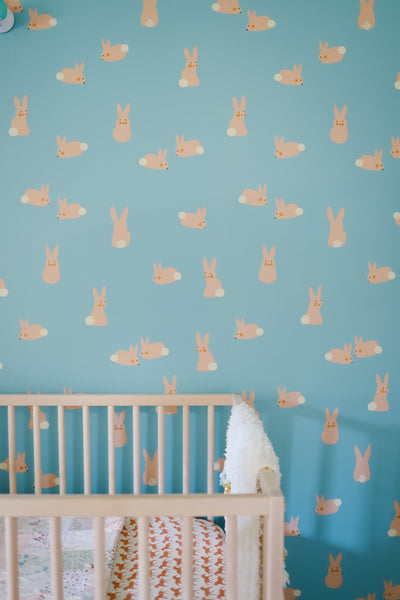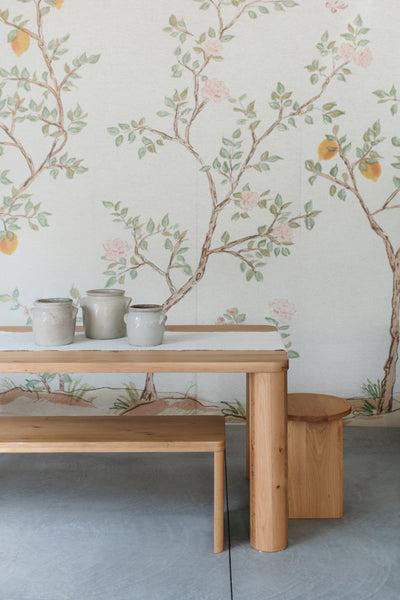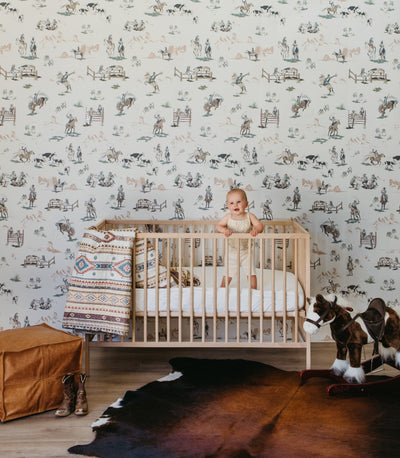
Are you interested in transforming your space with a stunning mural or wallpaper?
Well, your first point of order is measuring the walls.Precise measurements are the foundation of any successful wallpapering project.
They ensure a seamless installation, prevent waste, and help you avoid common issues like gaps, overlaps, or running short of material. With accurate mapping, you'll not only achieve a perfect wall-to-wall fit but also save money and reduce unnecessary waste.
This brings us to the purpose of today’s blog: Gathering all the necessary measurements before placing a wallpaper order can be confusing, and even a little intimidating.
In this guide, we'll walk you through clear, step-by-step instructions on how to measure walls for wallpaper and murals. Whether covering a single accent wall or an entire room, we'll help you achieve a perfect fit.
Let's begin your DIY wallpaper how-to transformation!
A Step-by-Step Guide to Measure Walls for Wallpapers & Murals
Accurate wall measurement is the bedrock of a successful wallpaper or mural installation.
It's not just about getting the numbers right; it's about ensuring your vision comes to life seamlessly on the walls. Proper measurement also helps in achieving that perfect, customized look you're dreaming of.
Let's roll up our sleeves and dive into the nitty-gritty of how to measure your walls for wallpaper.
Step 1: Gather Your Tools
First, you have to gather the required tools for accurate measurements. Just as our designers carefully select their materials, having the right measuring equipment at hand is important. Here's what you'll need to capture your wall's dimensions with precision:
- Measuring tape or laser distance meter: Your go-to for accurate length measurements.
- Digital level: Ensures your measurements are perfectly straight and aligned.
- Chalk: Useful for marking key points on your walls without leaving permanent marks.
- Pencil & Notepad: For jotting down measurements as you go.
Step 2: Measure the Height of the Wall
Now that we're equipped, let's tackle the first dimension: height.
When it comes to measuring height, starting from the right point is crucial. We've seen folks measure from the top of their baseboards or stop at the bottom of their crown molding.
While it might seem logical, it can leave you short on wallpaper when it's time to install. Here's how to get it right:
- Position your measuring tape or laser meter at the floor, right against the baseboard.
- Extend it straight up to the ceiling, including any crown molding in your measurement.
- If you're dealing with a sloped or angled ceiling, measure at the highest point to ensure full coverage.
- Note down this height measurement in inches. Since our standard size options are in inches, measuring in inches will help you decide if you need a custom quote.
Remember, when it comes to how to measure walls for wallpaper, accuracy is key. A fraction of an inch can make a difference. So, don't hesitate to double-check your measurements.
This attention to detail will pay off when you see your Anewall wallpaper perfectly fitted to your space.

Step 3: Measure the Width of the Wall
With the height of your wall measured, it's time to tackle the width. This step is essential in understanding how to measure a room for wallpaper, especially if you're planning to cover multiple walls. Here's how to get an accurate width measurement:
- Start at one corner of the wall and extend your measuring tape to the opposite corner.
- Include any windows or doors in this measurement - we'll cover why this is important in a moment.
- If your wall isn't perfectly straight, measure at the widest point to ensure full coverage.
- Jot down this width measurement alongside your height measurement.

Step 4: Measuring Walls with Built-in Obstacles
Next, let's tackle a common challenge in wall measurement: built-in obstacles like windows and doors. It's tempting to subtract these areas from your measurements, thinking you'll save on wallpaper.
But here's a warning: don't do it!
Instead, measure your wall as if these obstacles weren't there.
Why? Because when you're hanging wallpaper, you'll want continuous patterns and the flexibility to work around these features. Plus, having a little extra material gives you wiggle room for pattern matching and dealing with any unexpected challenges during installation.
It's a pro tip that can make a big difference in the final appearance of your Anewall wallpaper.

Step 5: Measure Additional Walls for a Multi-wall Room (if applicable)
If your vision involves covering more than one wall, don't worry! Measuring for multiple walls is simpler than you might think.
Here's how to approach measuring a room for wallpaper when you're going all out:
- Measure each wall separately as described in previous steps 2-4.
- Add up the total width of all walls you want to cover.
- Use the tallest height measurement if the walls vary in height.
- Your final measurement will be: (W1 + W2 + W3) x H, where W represents the width of each wall and H is the height.

This method ensures you have enough wallpaper to create a stunning, cohesive look across your entire space. It's perfect for creating an immersive atmosphere with your chosen Anewall design.
Step 6: Send Measurements for a Custom Quote
Finally, it's time to bring your vision to life!
If your dimensions fit our standard size options, choose your preferred wallpaper design and place an order online. However, if you find out your dimensions don’t fit our standard size options, fret not!
At Anewall, we create free custom quotes based on the measurements you provide. This personalized approach ensures that the patterns fit perfectly within your space.
Here's how to get your custom quote:
- Choose your preferred wallpaper design from our collection.
- Decide the type of wallpaper (pre-pasted, traditional, or peel and stick).
- Send us your wall measurements along with the design and type details.
- We'll get back to you with a custom quote within 1-2 business days.
This custom approach allows us to tailor your wallpaper to your exact specifications, ensuring a perfect fit and minimal waste. To ensure ease of installation, we automatically add an extra 4 inches of excess wallpaper to your custom dimensions.
After you finish the project, if you still have some excess wallpaper, check out our ‘19 Wallpaper Design Ideas Using Wooden Frames for Every Space’ blog to see how you can use the scraps and turn it into decor pieces!
What are Some Common Measuring Mistakes and How to Avoid Them
Brimming with the knowledge from the comprehensive guide on measuring walls for wallpaper? Well, it is time to address some common pitfalls that even seasoned DIY enthusiasts face.
Measuring walls seems simple, but common mistakes can derail your wallpaper project. Let's explore these potential pitfalls and how to avoid them, ensuring precise measurements for your Anewall wallpaper.
1. The "Measure Once and Done" Approach
Even with our detailed guide in hand, it's tempting to measure once and call it a day. But here's a nugget of wisdom from our design experts: always measure twice. It might feel like overkill, but it's a small investment of time that can save you from a world of frustration later.
Why is this so important? Well, even the steadiest hands can slip, and even the most eagle-eyed among us can misread a number. By taking a second set of measurements, you're giving yourself a chance to catch any discrepancies before you place your order. Remember, your Anewall wallpaper is custom-made for your space - we want those measurements to be spot on!
2. Not Considering Wallpaper Patterns Mistake
Ah, patterns - they're what make Anewall Pattern wallpapers so stunning. However, a key concept to understand is the "pattern repeat." This refers to the vertical distance from where a design starts to where it begins again. For instance, if you see flowers that reappear every 24 inches up the wallpaper, the pattern repeat is 24 inches.
Understanding pattern repeat is crucial for two reasons. First, it ensures that your wallpaper designs align perfectly when you hang multiple strips side by side. Second, it helps you order the correct amount of wallpaper. Ignoring the pattern repeat can lead to mismatched designs on your walls and potentially not having enough material to complete your project.
By avoiding these two common pitfalls, you're paving the way for a smooth installation process and a result that'll make you smile every time you enter the room.
Take your Pick from Anewall's Wallpaper Types
At Anewall, we believe in unique, artistic options that suit your personal style and needs. Whether you're a DIY enthusiast, a renter looking for a temporary solution, or someone who prefers a luxurious, professional finish, we've got you covered. Let's explore our three main types of wallpaper and help you find your perfect match.
1. Pre-pasted Wallpaper
Classic semi-matte finish for a timeless look. This permanent option only needs water to activate its pre-applied adhesive. Ideal for DIY enthusiasts, it's our simplest installation method.
2. Traditional Wallpaper
Luxurious flat-matte finish on our thickest material. Requires separate wallpaper paste and professional installation. Perfect for those seeking a high-end, long-lasting result.
3. Peel & Stick
Temporary solution with a semi-matte finish. Easily removable, making it ideal for renters or frequent redecorators. While designed for DIY, professional installation is recommended due to its precise application process.
|
Our standard sizes are:
|
Whether you prefer the flexibility of Peel & Stick or the enduring beauty of our Pre-pasted and Traditional options, Anewall offers a range of designs to suit your chosen wallpaper type.
We hope this guide has not only simplified the process of measuring your walls but also helped you understand the different wallpaper options available to you.
Transforming your space is about more than just measurements - it's about choosing the right product that fits your lifestyle and design dreams.
Please feel free to reach out to us at hello@anewall.com with all your custom order inquiries or if you have any further questions at all.




I received your sample and would love to order a mural but my wall is 155” wide. No obstructions. The ceilings are 8’. Please advise best options.
Thank you
uHErsGIVdgklhe
nekSGaDhOJQd
yVNjGKvRptUBAwi
uRcgWAeolpjtYGXn
Leave a comment